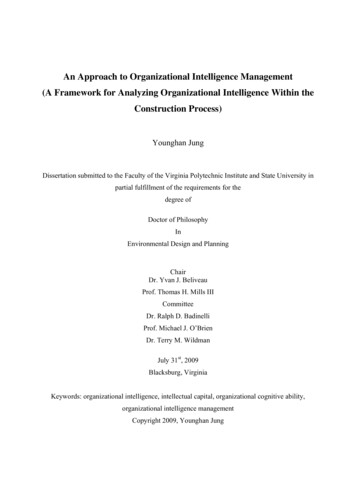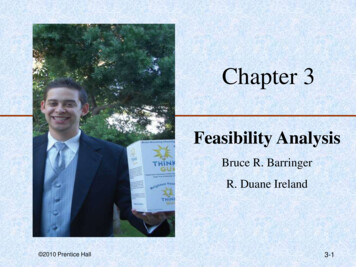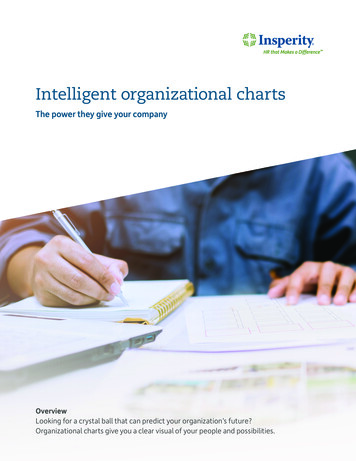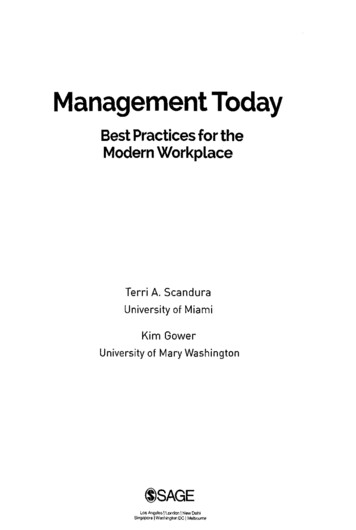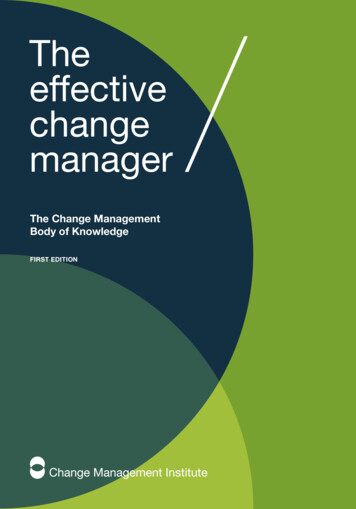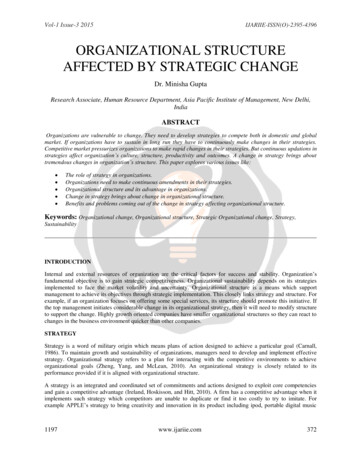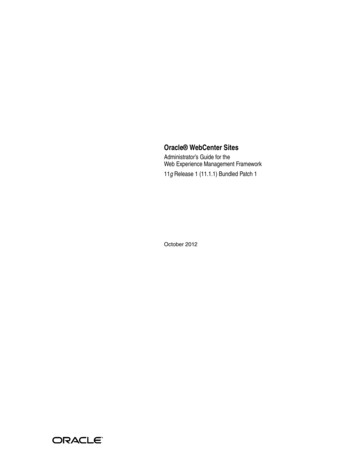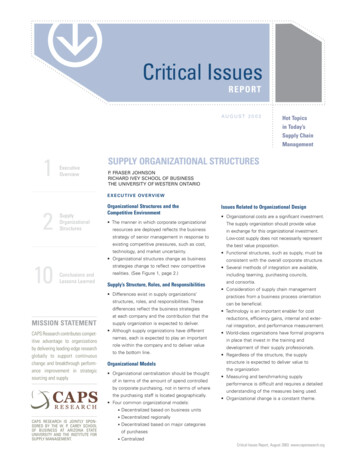
Transcription
State of CaliforniaOrganizationalChange ManagementFramework
ContentsCalifornia Department of TechnologyOrganizational Change Management FrameworkOverview381416Overview of the CA-OCMFramework Conventions and StructureAlignment to Other FrameworksOCM Knowledge AreasTemplates38ApproachCA-OCM TemplatesConcept3719ApproachKnowledge AreasProcess Phase ChecklistPage ii
ContentsCalifornia Department of TechnologyOrganizational Change Management FrameworkInitiating3730ApproachKnowledge AreasProcess Phase ChecklistPlanning3941ApproachKnowledge AreasProcess Phase ChecklistExecuting3953ApproachKnowledge AreasProcess Phase ChecklistPage iii
ContentsCalifornia Department of TechnologyOrganizational Change Management FrameworkClosing3827ApproachKnowledge AreasProcess Phase ChecklistAdditional Resources31114ApproachFramework ResourcesGlossaryPage iv
California Department of TechnologyDocument ControlOrganizational Change Management FrameworkVersion HistoryDocument history and version control is used to record detail of minor andmajor changes to the California Organizational Change Management Framework(CA-OCM).Version #1.0DateAuthor7.18.2017CDTChangesInitial PublicationPage v
California Department of TechnologyOrganizational Change Management FrameworkOverviewThis chapter provides an overview of theCalifornia Organizational Change ManagementFramework (CA-OCM), its purpose and use,and how it will help you with your projects.Overview Page 1
California Department of TechnologyOverviewOrganizational Change Management FrameworkIn this chapter.1234Overview ofthe CA-OCMFrameworkFrameworkConventionsand StructureAlignmentto OtherFrameworksOCMKnowledgeAreasPage 3Page 8Page 14Page 161.1 Purpose andUse of theCA-OCM2.1 Colors and IconConventions3.1 RelatedFrameworks4.1 Purpose ofKnowledgeAreas2.2 Chapters1.2 The Value ofthe CA-OCM1.3 A ThoughtfulApproachto OCM2.3 Key NavigationElements4.2 OCM KnowledgeAreas2.4 Call-Out BoxesOverview Page 2
OverviewCalifornia Department of TechnologyOrganizational Change Management FrameworkOverview of the CA-OCM FrameworkOrganizational Change Management (OCM) is a discipline that helpsorganizations implement change to achieve measurable results in their businessstrategies, work processes, structures, technologies, organizational cultures,and management styles. These changes can be driven by implementation ofa new mandate, process, technology, or strategy. OCM focuses on the peoplein the organization and on identifying and enhancing the “human factors” thatwill achieve and sustain desired project results, which can include improvedefficiency, quality, timeliness, and cost avoidance.The California Project Management Office (CA-PMO) has developed theCalifornia Organizational Change Management Framework (CA-OCM or OCMFramework) to provide an OCM Practitioner with a practical guide for managingchange within an organization. The CA-OCM provides guidance on OCM methodsand approaches through the use of resources, tools, and templates, as well asnarrative describing when and how specific OCM activities should be performedthroughout the Project Management Lifecycle (PMLC).While the CA-OCM is written in the context of information technology (IT)implementation efforts, it is applicable to any type of project that requires anorganization, its groups, and its people to change. This must be done with athoughtful approach that leverages best practices and lessons learned tohelp navigate California’s unique environment and characteristics. The OCMframework aligns to and can be used with the California Project ManagementFramework (CA-PMF) and the California Business Process ReengineeringFramework (CA-BPR or BPR Framework).1.1 Purpose and Use ofthe CA-OCMThe CA-OCM is designed to assist organizations in managing the people-sideof change in order to achieve business outcomes associated with that change.OCM facilitates the transition of individuals, teams, and organizations to afuture state to achieve business benefits. To accomplish this, OCM takes intoOverview Page 3
OverviewCalifornia Department of TechnologyOrganizational Change Management Frameworkconsideration the complete organization and how the organization and peopleneed to change. The CA-OCM provides a set of activities that: Address the people issues that arise when an organization tries tomake changes Facilitate communication to increase awareness and ownership Identify and promote leadership support Foster strong and healthy working relationships between project teams,the Project Sponsor, and Stakeholders Mobilize commitment of Stakeholders to implement a change initiative Proactively identify and address resistance to change Create a thoughtful training approach to provide opportunities for endusers to gain knowledge and skills in order to succeed in the future state.The CA-OCM is a practical and useful guide to assist an OCM Practitionerin implementing OCM efforts for projects of all sizes and complexity levels. TheCA-OCM provides recommended practices, activities, and tools/templates forOCM efforts, in addition to leveraging industry standards and resources.The intended audience for the CA-OCM includes Practitioners responsible forperforming or managing OCM activities, roles that may be held by state and/or contractor resources, and other team members that may be involved inan OCM effort. The CA-OCM also provides helpful information to the ProjectSponsor, project participants, and Stakeholders regarding OCM concepts andbest practices. The OCM Practitioner should leverage the tools/templates, asapplicable, and modify them to fit specific project needs.Projects in California vary in size, type, and complexity; however, despitethese differences, the objectives of OCM remain consistent. To account for anorganization’s specific project needs, the OCM approach and methods usedwill need to be tailored to the specific organization and project. The OCMPractitioner should adjust the level of complexity and rigor to match the needsof each individual project, and recognize that the level of complexity andrigor will differ from project to project. The CA-OCM provides guidance andadaptability to account for these project differences.Overview Page 4
OverviewCalifornia Department of TechnologyOrganizational Change Management Framework1.2 The Value of the CA-OCMThe CA-OCM provides a common foundation for state organizations to leverageand apply to project implementation efforts, to strive for a level of efficiencyand consistency in OCM practices across the state. The many benefits include:1. A guide for OCM Practitioners across a range of experience levels, usingpractical language and concepts that are easy to understand and apply.2. An OCM framework, nomenclature, and toolset with templates,examples, and instructions that can be customized to account fordifferences in project needs, but are structured to be consistentlyapplicable across a wide range of project types, sizes, and complexities.3. Guidance based on industry standards, best practices, andlessons learned.4. A statewide OCM perspective which addresses the relationshipsbetween OCM activities, project management activities, BPR activities,Project Approval Lifecycle (PAL) activities, and system developmentactivities.1.3 A Thoughtful Approachto OCMThe CA-OCM offers a set of tools and techniques to provide a structured,disciplined, and repeatable approach to OCM. Though a set of tools andtechniques can increase the likelihood of success, OCM also requires theappropriate skills and experience to apply them. The ultimate success of an OCMeffort depends on the knowledge, skills, and abilities of the OCM Practitioner.An OCM Practitioner needs to be able to proactively identify change-relatedissues and to anticipate and plan for such challenges, mitigate issues as theyarise, and work cohesively and effectively with a wide range of individuals. Inleading OCM efforts, the OCM Practitioner should possess a set of knowledge,skills, and abilities that enable effective OCM activities and contribute to overallproject success.Overview Page 5
OverviewCalifornia Department of TechnologyOrganizational Change Management FrameworkKnowledge Organizational change management concepts and methodologyknowledge. While the CA-OCM describes key concepts, it is important forthe OCM Practitioner to have OCM experience in order to effectively applythe OCM activities, tools, and templates, however, depending on that levelof experience the value provided may fluctuate. Integration of strategy, technology, business processes, and people.The OCM Practitioner works in connection with many team members fromother disciplines, including project management, technology, and businessanalysis. Successful OCM efforts depend on the thoughtful integrationbetween these disciplines. As such, the OCM Practitioner must possess anunderstanding of these additional disciplines and the interrelationshipsbetween them. Human resources processes and practices. As part of the transition to afuture state, the OCM Practitioner needs to be aware of human resourceprocesses and practices. Such processes and practices are integral inidentifying impacts on change activities, as well as changing job rolesand classifications.Skills Strategic Thinking. Effective OCM requires the OCM Practitioner to have asolid understanding of the organization and anticipate people’s reactions tochange. It requires strategic thinking, since the OCM Practitioner will need toidentify a strategy to address OCM priorities and issues on the project. Problem-solving. The OCM Practitioner identifies people-related issues,assesses those issues, and determines the most appropriate solutions.The OCM Practitioner routinely uses problem-solving skills throughout theproject and draws upon past experience to aid in decision-making. Collaboration and teamwork. The OCM Practitioner should demonstratean ability to foster positive team dynamics and promote collaborationwithin the team. While the OCM Practitioner focuses on facilitating thepeople-side of change initiatives, the entire project team must work inconcert for projects to be successful. Communication. The OCM Practitioner should be able to effectivelycommunicate and serve as a facilitator to help achieve the project’sobjectives. The OCM Practitioner needs to create meaningful messages anddeploy communication techniques to foster effective participation.Overview Page 6
OverviewCalifornia Department of TechnologyOrganizational Change Management Framework Listening. The OCM Practitioner should possess strong listening skills andempathy to gain trust and to be able to proactively address employees’resistance to change.Abilities Build team effectiveness. The OCM Practitioner helps build and supporteffective project teams, moving them from the “forming” stage to the “highperforming” stage. Leadership and influence. The OCM Practitioner provides leadershipthroughout a change initiative. The OCM Practitioner needs to buildrelationships, engage with Stakeholders to gain support, and create ahigh level of trust.Overview Page 7
OverviewCalifornia Department of TechnologyOrganizational Change Management FrameworkFramework Conventions and StructureThis section of the CA-OCM describes the conventions and structure that is usedthroughout. The graphical elements, strategic use of color, and call-out boxesare used to clearly communicate practical OCM concepts, as well as engage thereader’s attention and improve information retention. The structure of the CAOCM also organizes information through the use of chapters, knowledge areas(which are described later in this chapter), and key navigational elements toguide the reader.2.1 Colors and Icon ConventionsEach chapter of the CA-OCM corresponds to a process phase of the PMLC and isidentified with a specific color and distinct icon. These unique colors and iconsare presented at the beginning of each chapter and continue throughout tovisually guide readers as they progress through the document.Groupings of related OCM activities are organized into knowledge areas. Theseserve to organize sets of OCM activities that share a common purpose andobjective. Activities from multiple knowledge areas may occur within a singleprocess phase. These knowledge areas are represented by their own icons andcolors placed below each PMLC process phase chapter header. The methodicaluse of color is designed to help readers navigate the CA-OCM quickly and easily.Icons used throughout this framework are shown by grouping for your sRolesOutputsSkillsOverview Page 8
OverviewCalifornia Department of TechnologyOrganizational Change Management FrameworkProject ManagementLifecycleOrganizationalChange ManagementConceptOCM Leadership SupportExecutingTeam DynamicsClosingStakeholder EnrollmentTrainingOverviewTemplatesAdditional ResourcesOverview Page 9
OverviewCalifornia Department of TechnologyOrganizational Change Management Framework2.2 ChaptersThe CA-OCM is comprised of eight chapters. These chapters organize contentinto logical domains to help readers easily navigate the document. The eightchapters of the OCM framework are:OverviewThis initial chapter provides an introduction to the CA-OCM and itspurpose and use. It discusses how specific icons and colors are usedto facilitate navigation. It also offers a high-level overview of theOCM lifecycle and knowledge areas, which are core elements of theOCM effort.TemplatesThis chapter contains information about the collection of templatesthat are available as part of the CA-OCM to help the OCM Practitionersuccessfully conduct an OCM effort.ConceptThis chapter describes initial OCM activities at the inception ofa change initiative. The goals of this process phase are to definethe change initiative and communicate it to key leaders andStakeholders.InitiatingThis chapter provides guidance on how to identify OCM priorities andschedule OCM activities. In this process phase, the OCM Practitionerengages the Project Sponsor and other key executive leaders anddefines the project team behavior guidelines.PlanningThis chapter provides recommendations for the OCM effortduring the Planning Process Phase. The OCM Practitioner willplan and implement OCM activities, facilitate high level projectcommunications, engage key Stakeholders and leaders, and assistin building the project team.Overview Page 10
OverviewCalifornia Department of TechnologyOrganizational Change Management FrameworkExecutingThis chapter provides guidelines for the OCM Practitioner touse throughout the Executing Process Phase when the systemdevelopment activities begin. The OCM Practitioner works to engageand transition individuals and the organization to the future state.ClosingThis chapter details the principles, practices, and tools used duringthe final process phase. This process phase concludes the formalOCM effort by closing out OCM activities, transitioning remainingOCM responsibilities, and planning for ongoing training needs.Additional ResourcesThis chapter provides resources to support the CA-OCM. It includesa glossary of project roles and common OCM terms.Overview Page 11
OverviewCalifornia Department of TechnologyOrganizational Change Management Framework2.3 Key Navigation ElementsThe CA-OCM contains seven categories of information to help the OCMPractitioner navigate the framework. These categories, referred to as keyelements, include:Recommended PracticesTechniques or methods that, through experience and research, helpachieve a desired result.InputsInformation and/or documents that feed into a process.RolesRoles for project Stakeholders, including a list of key responsibilitiesassociated with process phase and knowledge area activities.SkillsSpecial or unique human expertise that should be applied to achievea successful project outcome.ActivitiesActions or activities for the OCM Practitioner to undertake.ToolsTemplates or other resources to help create project outputs. Templatesare documents that have been pre-developed for project use.OutputsWork products that are developed.Overview Page 12
California Department of TechnologyOverviewOrganizational Change Management Framework2.4 Call-Out BoxesThroughout the CA-OCM, “call-out” boxes are used to bring attention toinformation that further supports the narrative. These graphics have beenincorporated into the document to highlight useful information at a glance.Examples of call-out boxes may include: Navigation elements: recommended practices to consider, inputs toreview, roles involved, guidelines to follow, activities to undertake,tools available for assistance, and outputs to create Skills that are useful for a particular activity Website links or other references for more information Quotes and that are highlighted for greater emphasisRecommendedPracticesInputsReview recommendedpractices at the start ofthe process phase.The following is aninput to the activity: EnvironmentalReadiness AssessmentToolsOutputsA template is available:Change MagnitudeAssessmentThe following is anoutput of the activity: Completed ChangeMagnitude AssessmentRolesFor a complete list ofall CA-OCM roles, see theOCM Role Definitionsin the Glossary.iSkillsUse the following skills tocomplete the activity: Strategic Thinking TeamworkWeb Link/ InfoSee the Human Resources& Staff Managementsection within thePlanning Process Phasechapter of the CA-PMF.When the project purposeand desired outcomes arevague, the risk of projectscope creep is very high.Overview Page 13
OverviewCalifornia Department of TechnologyOrganizational Change Management FrameworkAlignment to Other Frameworks3.1 Related FrameworksThe CA-OCM aligns with the CA-PMF and other frameworks that support theproject implementation effort. CA-OCM activities span the PMLC and are groupedwithin PMLC process phases. It is important to recognize the integration pointsamong the different frameworks and their associated lifecycles.The OCM lifecycle refers to a series of activities that are conducted to addressthe people-side of a change initiative. This effort spans throughout the entirePMLC. The design accommodates projects that vary in size, complexity, andtype, and all project OCM efforts can be aligned to the PMLC structure.In addition to the PMLC, the OCM Lifecycle also aligns with: Business Process Reengineering (BPR) Lifecycle Project Approval Lifecycle (PAL) System Development Lifecycle (SDLC)During project implementation, the OCM Lifecycle, PMLC, BPR Lifecycle, andSDLC may support one another and often occur in parallel. Figure 3-1 depicts theOCM Lifecycle in association with these lifecycles. The successful managementof each lifecycle can greatly affect the others and contribute to the success of theoverall project. In addition to these lifecycles, California has adopted the ProjectApproval Lifecycle (PAL) to improve the quality, value, and likelihood of success oftechnology projects undertaken by the State of California.Overview Page 14
California Department of TechnologyOverviewOrganizational Change Management FrameworkProject Management Lifecycle anizational Change Management (OCM) LifecycleBusiness Process Reengineering (BPR) LifecycleProject Approval Lifecycle (PAL)System Development Lifecycle (SDLC)Figure 3-1Overview Page 15
OverviewCalifornia Department of TechnologyOrganizational Change Management FrameworkOCM Knowledge AreasThe CA-OCM is comprised of six knowledge areas. A knowledge area groupsa set of OCM activities that share a common purpose and objective and canspan across multiple PMLC process phases. This section describes the six OCMknowledge areas including the purpose, objectives, and timing within the PMLC.4.1 Purpose ofKnowledge AreasThe purpose of the OCM knowledge areas is to group the concepts the OCMPractitioner needs to understand and the associated activities he/she will needto perform. It is important to note that knowledge areas and their associatedactivities often have interdependencies and interrelationships with other OCMknowledge areas. The six knowledge areas of the CA-OCM are: OCM Lifecycle Management Communication Leadership Support Team Dynamics Stakeholder Enrollment TrainingThe CA-OCM provides guidance on when specific knowledge area activitiesshould occur during a project. The CA-OCM presents the knowledge areas inthe general order in which they begin within the PMLC; however, each OCMPractitioner will need to determine applicability and timing, and align OCMactivities to the specific needs of a project. Guidance on tailoring OCM efforts tospecific projects and project needs is provided throughout the CA-OCM.Overview Page 16
California Department of TechnologyOverviewOrganizational Change Management Framework4.2 OCM Knowledge AreasKnowledge areas span multiple process phases and occur at different timesduring the PMLC. Figure 4-1 identifies the OCM knowledge area goal withineach process phase where there are associated activities. Additionally, a single,overarching goal is presented for each knowledge area.OCM ingClosingUnderstandthe Magnitudeof ChangeScheduleInitiating ActivitiesSchedulePlanning ActivitiesScheduleExecuting ActivitiesCloseOCM EffortEnsure the Performance of the OCM EffortImplementPlanning Process PhaseCommunicationsCommunicationCommunicateKey Project MessagesCommunicateOperationsEnsure Common UnderstandingLeadership SupportSelectProject SponsorEngageProject Sponsor andKey LeadersSupportProject SponsorEngageLeadersEnsure Leadership Demonstrates Visible SupportTeam DynamicsDevelopTeam FoundationInitiatePlanning Project TeamMonitorTeam DynamicsEnsure High Performing TeamStakeholderEnrollmentEnrollStakeholdersEnsure Stakeholder Buy-inTrainingDefineTraining RequirementsConductTrainingEvaluateTrainingEnsure Users Have the Necessary KSAsFigure 4-1Overview Page 17
OverviewCalifornia Department of TechnologyOrganizational Change Management FrameworkThe following provides a brief description of the six OCM knowledge areas:OCM Lifecycle ManagementOCM Lifecycle Management focuses on managing the performance of the OCMeffort through the planning and scheduling of OCM activities. These activitiesguide the direction and govern the sequence and resourcing of all otherknowledge area activities. OCM Lifecycle Management requires continuouscoordination with the Project Manager to ensure the OCM effort is integratedwith other project activities and milestones.CommunicationCommunication focuses on ensuring a common understanding of thechange effort through communication and feedback activities. It works toinform and engage those involved with and affected by the change initiative.Communication is a vital component of the OCM effort as it creates awarenessand understanding of the change to obtain Stakeholder buy-in and reduceemployee resistance.Leadership SupportLeadership Support focuses on ensuring that leadership at all levelsdemonstrates visible support for the change. Leadership Support activitiesguide the effort to engage and support all leaders influential to or impactedby the change, from the Project Sponsor to managers and supervisors. Theseleaders, in turn, provide visible change support and serve as role models toother Stakeholders.Team DynamicsTeam Dynamics focuses on creating and maintaining high performing teams.Team Dynamics activities are tailored around team and individual expectationsand guidelines and are designed to create a positive and collaborative workingenvironment. Team Dynamics may focus on the project team and sub teams, orany other collaborative group.Overview Page 18
OverviewCalifornia Department of TechnologyOrganizational Change Management FrameworkStakeholder EnrollmentStakeholder Enrollment focuses on ensuring Stakeholder buy-in. Stakeholdersinclude persons or groups who are directly or indirectly affected by a project,as well as those who may have the ability to influence its outcome. StakeholderEnrollment builds on the Stakeholder identification, analysis, and managementactivities that are prescribed by the CA-PMF. Efforts in this knowledge areaserve to connect with Stakeholders at all levels to ensure they are informed andaccepting of the change initiative.TrainingTraining focuses on ensuring end users have the necessary knowledge, skills, andabilities (KSAs) they need to transition and be successful in a new environment.Activities in this knowledge area plan for, build, and implement a training programthat allows end users to be better prepared to adopt the new system.Overview Page 19
California Department of TechnologyOrganizational Change Management FrameworkTemplatesThis chapter describes the collection oftemplates that are referenced in the CaliforniaOrganizationalChangeManagementFramework (CA-OCM). These are designed tosupport the OCM effort throughout the entireproject lifecycle.Templates Page 1
TemplatesCalifornia Department of TechnologyOrganizational Change Management FrameworkIn this chapter.12ApproachCA-OCMTemplatesPage 3Page 81.1 Advantages ofUsing Templates2.1 ConceptProcess Phase1.2 TemplateSourcesReferenced inthe CA-OCM2.2 InitiatingProcess Phase1.3 CA-OCMTemplate Types1.4 Templates byKnowledge Areaand ProcessPhase2.3 PlanningProcess Phase2.4 ExecutingProcess Phase2.5 ClosingProcess PhaseTemplates Page 2
TemplatesCalifornia Department of TechnologyOrganizational Change Management FrameworkApproachOrganizational Change Management (OCM) is a discipline that follows a consistentseries of activities. The CA-OCM provides standardized templates to accompanykey activities. These templates are a core component of the CA-OCM and will helpthe OCM Practitioner document activities and provide clear, meaningful results.In some cases, the CA-OCM refers to these templates as “tools.” A template, justlike any other tool, helps get the job done.1.1 Advantages ofUsing TemplatesPre-developed templates offer the OCM Practitioner a standardized method forthe collection, analysis, and documentation of OCM-related content requiredthroughout the CA-OCM. This standardization reduces the time to complete OCMactivities, increases transparency into OCM activities, reduces risk, and improveoutcomes. Some organizations may already possess well-developed OCMtemplates; however, the OCM Practitioner may still benefit by supplementingtemplates that exist within the organization with those that are part of the CA-OCM.1.2 Template SourcesReferenced in the CA-OCMThe CA-OCM references and links to a variety of supporting templates designed fora specific purpose and with the objective of guiding the OCM Practitioner throughimplementing OCM activities. There are two main sources of templates referencedin the CA-OCM.1.2.1 CA-OCM TemplatesThe CA-OCM templates are designed to enable project teams to manage thechange associated with project implementations and/or Business ProcessTemplates Page 3
TemplatesCalifornia Department of TechnologyOrganizational Change Management FrameworkReengineering (BPR) projects successfully, consistently, and efficiently. Thesetemplates are specific to OCM activities and will help the team plan, assess,and implement organizational change. The CA-OCM templates support OCMactivities through all process phases.1.2.2 CA-PMF TemplatesThe California Project Management Framework (CA-PMF) templates aredesigned to help Project Managers keep the project on schedule, onbudget, and on time. CA-PMF templates provide Project Managers with theresources to manage all aspects of a project, including requirements, risk,schedule, scope, deliverables, cost, communication, and changes. CA-PMFtemplates are leveraged to support OCM activities where there are outputsthat are the same or similar in content. CA-PMF templates are available at:http://capmf.cio.ca.gov/Templates.html.iWeb LinksLeverage the CA-PMFtemplates whereapplicable: CA-PMFTemplates.1.3 CA-OCM Template TypesCA-OCM templates have been developed to accommodate differences in theexperience of the OCM Practitioner. As a result, the CA-OCM templates havebeen designed in two formats or types: templates with instructions for thosethat require more guidance and template shells for those with more experience.1.3.1 Templates with InstructionsTemplates with instructions contain a significant amount of instructiondescribing how to complete the template. These templates are intended for theless experienced OCM Practitioner. The instructions serve as a guide and can bedeleted as the template is completed. Many templates with instructions alsocontain examples and sample text that may be helpful. This text may also bedeleted or modified to suit the needs of the project as the template is completed.1.3.2 Templates ShellsTemplate shells contain the same template structure and content headingsas the templates with instructions; however, they do not include significantamounts of instructional text or examples. Template shells are intended toassist the more experienced OCM Practitioner who is already familiar withsimilar tools and prefers to use a shell template, and/or those that havepreviously worked with the template with instructions and prefer to now startwith a template shell.Templates Page 4
TemplatesCalifornia Department of TechnologyOrganizational Change Management Framework1.4 Templates by KnowledgeArea and Process PhaseSome of the templates that are used during the CA-OCM are used throughoutmultiple process phases. The table below lists each of the templates byknowledge area and identifies which process phases it is being used in.To access the templates in a fillable format see the CA-OCM website at the following link:http://projectresources.cio.ca.gov/ocm or by cl
Organizational Change Management (OCM) is a discipline that helps organizations implement change to achieve measurable results in their business strategies, work processes, structures, technologies, organizational cultures, and management
